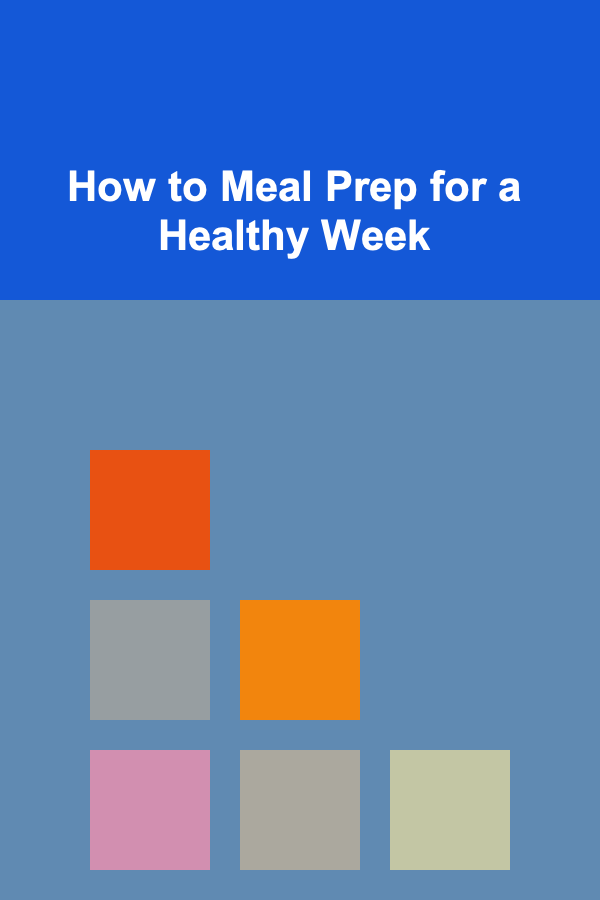
How to Meal Prep for a Healthy Week
ebook include PDF & Audio bundle (Micro Guide)
$12.99$10.99
Limited Time Offer! Order within the next:

Meal prepping is one of the most effective ways to ensure that you eat healthy, save time, and reduce stress during the week. Whether you're juggling a busy work schedule, managing family commitments, or trying to improve your eating habits, planning and preparing your meals in advance can make a significant difference.
In this comprehensive guide, we will explore how to meal prep for a healthy week, covering everything from meal planning to storage, to help you stay on track with your nutrition goals.
Why Meal Prep is Important for Healthy Eating
Meal prepping is not just about convenience; it's also a strategy for making healthier food choices and achieving your nutritional goals. Here are several reasons why meal prepping can be so beneficial:
1.1 Saves Time and Reduces Stress
With meal prep, you take care of all the cooking and meal decisions ahead of time. This allows you to save time on weekdays when you are often pressed for time. Instead of scrambling to figure out what to eat or cooking from scratch every day, your meals are ready to go, saving you time and reducing daily stress.
1.2 Control Over Ingredients and Portions
When you meal prep, you have complete control over what goes into your meals. You can choose fresh, nutritious ingredients and avoid the unhealthy additives and excess sodium often found in pre-packaged or fast food. It also helps with portion control, which is essential for maintaining a healthy weight.
1.3 Increases Consistency
Having meals prepared and ready to go helps you stay consistent with your eating habits. When healthy meals are convenient and accessible, you're less likely to reach for unhealthy snacks or takeout. This consistency is key to achieving long-term health and fitness goals.
1.4 Promotes Nutritional Balance
Meal prepping allows you to plan and balance your meals to ensure you're getting the right proportions of macronutrients---protein, fats, and carbohydrates---as well as vitamins and minerals. This can help you meet specific dietary goals like weight loss, muscle gain, or maintaining a balanced diet.
Meal Planning: The First Step to Healthy Prep
The key to successful meal prepping is proper planning. Without a plan, it's easy to waste time and money or prepare meals that don't align with your goals. Here's how to get started with meal planning:
2.1 Set Your Nutritional Goals
Before diving into meal prepping, it's essential to know what your nutritional goals are. Are you trying to lose weight, gain muscle, or simply maintain a healthy diet? Setting clear goals helps you determine how many calories you should be consuming each day, as well as the appropriate balance of macronutrients.
For example:
- Weight loss: A calorie deficit is needed (eating fewer calories than you burn).
- Muscle gain: A slight calorie surplus and more protein intake are recommended.
- Maintenance: Balanced meals that support energy and overall health.
Knowing your goals will guide your portion sizes, food choices, and meal composition.
2.2 Create a Weekly Menu
Now that you have your goals in mind, it's time to create your weekly menu. A well-rounded meal plan should include a variety of protein sources (chicken, fish, tofu, beans, etc.), vegetables, healthy fats (avocados, olive oil, nuts), and whole grains (brown rice, quinoa, oats).
When creating your meal plan, try to consider:
- Breakfast, lunch, and dinner options.
- Healthy snacks for between meals.
- A mix of cooking methods (roasting, grilling, steaming, etc.) to keep meals interesting.
- Variety in flavors and textures (use different spices and herbs).
A simple menu might look like this:
- Breakfast: Scrambled eggs with spinach, avocado toast, and oatmeal with berries.
- Lunch: Grilled chicken with quinoa and steamed broccoli.
- Dinner: Baked salmon with roasted sweet potatoes and a mixed green salad.
- Snacks: Greek yogurt, almonds, protein bars, fruit, and carrot sticks with hummus.
2.3 Plan for Leftovers
One of the benefits of meal prepping is that you can cook larger batches of food and repurpose leftovers throughout the week. For example, you might roast extra chicken or cook a double batch of rice to use for multiple meals.
Incorporating leftovers can also save time and reduce the need to cook every single meal from scratch.
Grocery Shopping for Your Meal Prep
Once your meal plan is ready, it's time to shop for the ingredients. Shopping in bulk can help save money and reduce the number of trips to the store. Here are some tips for a successful grocery shopping trip:
3.1 Make a Detailed Grocery List
Based on your meal plan, create a detailed shopping list. Organize the list by food categories such as produce, dairy, protein, grains, and snacks. This helps you stay focused and ensures you don't forget any ingredients.
3.2 Buy in Bulk Where Possible
Buying items like rice, beans, oats, and frozen vegetables in bulk is a cost-effective way to stock up on pantry essentials. You can also buy larger cuts of meat and portion them yourself for the week.
3.3 Shop the Perimeter of the Store
Most grocery stores have fresh produce, meats, and dairy around the perimeter. Stick to the outer aisles for healthier, whole-food options, and avoid the middle aisles where processed foods are typically located.
Preparing and Cooking Your Meals
Meal prepping isn't just about cooking---it's about cooking smart. Here's how you can prepare your meals efficiently:
4.1 Batch Cooking
One of the most effective ways to meal prep is through batch cooking, where you prepare large quantities of a single dish that can be divided into individual portions for the week. For example, cook a big pot of chili, roast a large tray of vegetables, or grill several pieces of chicken. Batch cooking allows you to cook once and eat multiple times.
4.2 Cook Versatile Ingredients
Some ingredients are versatile and can be used in a variety of meals. For example, grilled chicken can be used in salads, wraps, or stir-fries. Roasted sweet potatoes can be paired with different proteins or used in salads. By preparing ingredients that can be easily repurposed, you avoid monotony and make your meals more interesting.
4.3 Invest in Good Kitchen Tools
Having the right kitchen tools can make meal prepping much easier. Essential tools include:
- A slow cooker or Instant Pot: For hands-off cooking, especially for stews, soups, and grains.
- Sharp knives: To make chopping vegetables and meats quick and easy.
- Storage containers: To store prepped meals and ingredients. Look for glass containers that are microwave-safe, freezer-safe, and airtight.
Storing Your Meals
Proper storage is key to keeping your meals fresh and safe to eat throughout the week. Here are some tips for storing your prepped meals:
5.1 Use Airtight Containers
Invest in high-quality, airtight containers to prevent your meals from spoiling. Glass containers are ideal because they are durable, can be used for reheating, and don't absorb odors.
5.2 Portion Your Meals
When storing your meals, portion them out into individual containers so you can easily grab and go. This will also help you control your portion sizes and avoid overeating.
5.3 Refrigerate or Freeze Meals
Meals that you plan to eat within 3-4 days should be stored in the refrigerator. For meals you won't eat until later in the week, store them in the freezer to maintain their freshness. Freezing meals can also help reduce food waste by allowing you to keep food for longer.
Reheating and Enjoying Your Meals
When it's time to eat, reheating your prepped meals should be quick and easy. Here are some tips for reheating:
6.1 Reheat Properly
To preserve the texture and flavor of your food, reheat it slowly, either in the microwave or on the stove. If you're reheating from frozen, let your meal thaw in the fridge overnight for best results.
6.2 Add Fresh Elements
While your prepped meals will be mostly ready to eat, consider adding fresh elements before serving. For example, add a fresh green salad, sprinkle fresh herbs over your dish, or top your meal with a dollop of avocado or yogurt to give it a boost of flavor and nutrients.
Tips for Successful Meal Prepping
Meal prepping can be overwhelming at first, but with these tips, you'll become more efficient and effective over time:
- Start simple: Don't try to prep a week's worth of complex meals right away. Start with a few basic meals and build up as you get more comfortable.
- Plan for variety: Avoid eating the same meals every day by rotating different proteins, vegetables, and grains.
- Stay organized: Keep track of your meal plan, ingredients, and preparation steps to stay on track.
- Prep in batches: Use your time wisely by preparing larger quantities of food to use throughout the week.
Conclusion
Meal prepping is a powerful tool for achieving your health goals and making your week more manageable. By planning ahead, shopping smart, and preparing your meals in batches, you can ensure that you're eating healthy and saving time throughout the week. With consistency and a little practice, meal prepping will become a simple, sustainable part of your routine, helping you stay on track with your nutrition and overall well-being.

How to Create and Sell Nutrition E-books or Meal Plans: A Step-by-Step Guide
Read More
How to Improve Room Acoustics with DIY Soundproofing
Read More
How to Learn to Jam with Other Musicians
Read More
How to Use Web Development to Make Money
Read More
How to Master the Neuroscience of Happiness and Well-being
Read More
How to Master Creative Photography Techniques
Read MoreOther Products

How to Create and Sell Nutrition E-books or Meal Plans: A Step-by-Step Guide
Read More
How to Improve Room Acoustics with DIY Soundproofing
Read More
How to Learn to Jam with Other Musicians
Read More
How to Use Web Development to Make Money
Read More
How to Master the Neuroscience of Happiness and Well-being
Read More